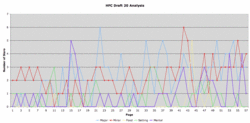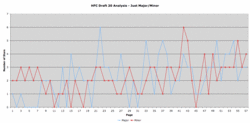Okay, so last time I blogged about the Gold Star Method. Now I have actually gone through and marked up my first 57 pages (six chapters) with stars. When I bought the packs of stars, they actually had gold, silver, blue, red, and green stars. So I used them as follows:
- Gold - Major good bit
- Silver - Minor good bit
- Blue - Eating disorder (theme)
- Red - Setting/Florida (theme)
- Green - Psychological problems (theme) [aka 'mental problems' for my short story readers]
I put the gold and silver stars in the left margin of the paper, and the other three (the themes) on the right. This took a while. Fortunately, I recently read the whole thing aloud to myself, so I was pretty familiar with it. I could recognize bits that I thought of as gold/silver stars easily -- and those are the most important. The others were sort of incidental, since I happened to have extra colored stars hanging around.
First lesson: it takes a lot of gold stars to mark up six chapters. I used a whole pack of 440 labels (stars provided by Avery), using up all the gold and silver stars, and about a quarter/third of the others.
Then I went through and plugged in all the star counts into a spreadsheet. This also took a while.
Second lesson: because of the way the document is formatted, a few pages are extra short. These are pages right before a chapter break. So they'll have artificially few stars. I added a column to my spreadsheet to note these, and ended up using that column to also track notes about particular pages -- explanations for why particular pages had lots of stars.
Third lesson: when you are tracking five data elements on the same image (see above), it's really hard to see what the hell is going on. So here is one with JUST the gold/silver (major/minor) stars:
Some Analysis of the Gold/Silver Stars
Fourth lesson: I don't see any clear relationship between gold and silver stars. They are not linked. So there are some pages with more silver stars than gold stars, and some the reverse. Sometimes there are none of one or the other.
Fifth lesson: Silver stars are more stable (in terms of number of stars per page) than gold stars. For most the period, you see one to three silver stars per page. This deviates in parts, but it's a pretty okay trend.
Sixth lesson: Something weird is happening between pages 1-12 in terms of gold stars, and 11-18 in terms of silver stars. This likely means that I should focus on these pages to spice them up.
Seventh lesson: What's happening on pages 29, 31, and 45? Those are all points where either gold or silver stars crash. Answer: 31 and 45 are both "short" pages before a chapter break, so we can ignore them. Page 29 is not a short page, but it has a healthy number of silver stars. Maybe figure out a way to cram a gold star onto this one.
Eighth lesson: overall star counts appear to go up as we get further into the story. I don't know what this means. Perhaps it means I had more to drink when I scored the later pages. Perhaps it means the later pages are better. If we assume drinking is not a factor in this equation, I think it means that the first 20 or so pages need attention.
So the whole point of this was to quantify the relative goodness of various pages. The logic is that pages with few/no gold/silver stars are not as good, and they need to be punched up. By punched up, I mean they need to be rewritten, as that is my current method of punching. I could have told you before this analysis that the first chapter (pages 1-12) had problems, but I didn't know the second chapter was also weak (it ends on page 19). HMM. Another interesting lesson is that parts of the story I used to think were pure gold are now just kinda meh. This keeps happening. Either this means that I'm getting better at this, or I just get sick of things I wrote a long time ago. Probably some of both.
Procedural note on the length of a page: for this analysis, we are talking about single-spaced pages with 1" margins, 12pt Times font. I gather that in The Industry one generally refers to One Page as a double-spaced page. So anyway, for whatever that's worth. I guess the point was that this is the first half of the book, as it represents 114 pages double-spaced, which is pretty close to half of the manuscript.
Ninth lesson: if we assume gold stars are the major indicator, page 22 is the best. This would make sense, as it's the page where we introduce Amry, the third main character, who is the focus of the following fifteen pages or so. Also, pages 33 and 37 seem pretty good. Page 33 is where we find out that Maggie (the fourth main character) has had a serious life event (ahem), and page 37 is in the middle of Amry's monologue about her past. So I knew before this that all of these were strong points, but it's interesting to see evidence of this on the chart.
Tenth lesson: it's hard to draw many conclusions about the other three colored stars. Looking at the combined chart (above, top), the only thing I can clearly see is that the "psychological problems" theme shows up pretty regularly. The others seem to come and go, and the eating disorder thing clearly spikes at one point. That makes sense. I think the good news is that the psych theme is indeed showing up consistently. In previous drafts, this wasn't the case -- I think I dropped this shoe way too late, without it being a part of the narrative. So that's good. I don't know what conclusions I can reach about the other themes...I think they're okay, since they're things that naturally come and go based on the action. So, like, whatever.
Question: did anybody read this far? If so, I am amazed at your interest in my work, and you deserve a free soda.
UPDATE: okay, after hearing from everybody and his mother, I realize that people did indeed read this far. Sodas all around.

